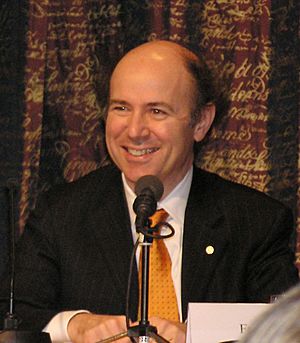Frank Wilczek facts for kids
Quick facts for kids
Frank Wilczek
|
|
|---|---|

Wilczek in 2004
|
|
| Born |
Frank Anthony Wilczek
May 15, 1951 Mineola, New York, U.S.
|
| Education | University of Chicago (BS) Princeton University (MA, PhD) |
| Known for | Asymptotic freedom Quantum chromodynamics Particle statistics Axion model Time crystal |
| Spouse(s) | Betsy Devine |
| Children | Amity and Mira |
| Awards | MacArthur Fellowship (1982) Sakurai Prize (1986) ICTP Dirac Medal (1994) Lorentz Medal (2002) Lilienfeld Prize (2003) Nobel Prize in Physics (2004) King Faisal Prize (2005) Templeton Prize (2022) |
| Scientific career | |
| Fields | Physics Mathematics |
| Institutions | Massachusetts Institute of Technology Shanghai Jiao Tong University Arizona State University Stockholm University |
| Thesis | Non-abelian gauge theories and asymptotic freedom (1974) |
| Doctoral advisor | David Gross |
Frank Anthony Wilczek (born May 15, 1951) is an American theoretical physicist and mathematician. He is famous for his work on the tiny particles that make up our universe.
In 2004, Wilczek, along with David Gross and H. David Politzer, won the Nobel Prize in Physics. They received this award for discovering something called "asymptotic freedom" in the theory of the strong interaction. This discovery helped explain how the smallest particles in an atom's core are held together.
He has also won many other awards, including the Templeton Prize in 2022. This prize recognized his work on the basic laws of nature, which has changed how we understand the forces that control our universe.
Contents
Early Life and Schooling
Frank Wilczek was born in Mineola, New York. His family was of Polish and Italian heritage. His father was a "self-taught engineer" who loved technology and science, which inspired his son.
Wilczek was a very bright student. He attended public schools in Queens and skipped two grades. He started high school when he was only 13 years old. His parents realized he was exceptional after he took an IQ test.
In high school, he was inspired by his physics teachers. He entered a national science competition and won fourth place for a project on a type of advanced math called group theory.
He went to the University of Chicago and earned a degree in Mathematics in 1970. He then went to Princeton University, where he switched from studying math to physics. He earned his Ph.D. in physics in 1974.
Major Discoveries and Research
Wilczek's work has helped us understand some of the biggest mysteries in physics. He has worked on particle physics, the study of the universe (astrophysics), and the physics of materials (condensed matter physics).
What is Asymptotic Freedom?
In 1973, while he was still a student at Princeton, Wilczek and his advisor David Gross made a groundbreaking discovery. They figured out something called asymptotic freedom.
This idea explains how quarks, the tiny particles inside protons and neutrons, behave. When quarks are very close to each other, the strong interaction (the force that holds them together) is very weak. They act almost like free particles. But as they move farther apart, the force gets much stronger, pulling them back together.
This discovery was a key piece in developing quantum chromodynamics, the theory that describes the strong force. It helped explain results from experiments at particle accelerators.
Searching for Axions
An axion is a hypothetical particle that scientists believe might exist. If axions are real, they could be a component of cold dark matter, the mysterious substance that makes up a large part of the universe.
In 1977, other scientists proposed a theory to solve a puzzle in physics. Wilczek and another physicist, Steven Weinberg, showed that this theory would create a new particle. Wilczek named this particle the "axion" after a brand of laundry soap. The search for axions is still a major focus of experiments today.
Anyons and Two-Dimensional Worlds
In physics, particles are usually either fermions or bosons. But Wilczek imagined a third type of particle that could exist only in flat, two-dimensional systems. In 1982, he named these particles anyons because their properties could be "anything" in between fermions and bosons.
Later, scientists discovered a strange effect in two-dimensional materials called the fractional quantum Hall effect. Wilczek's idea of anyons was needed to explain it. In 2020, scientists reported that they had finally detected anyons in an experiment.
The Idea of Time Crystals
In 2012, Wilczek proposed a strange and fascinating new idea: a time crystal. Most crystals, like salt or diamonds, have a pattern that repeats in space. A time crystal has a pattern that repeats in time, even without any energy being added. It's like a clock that ticks forever on its own.
At first, many scientists were skeptical. But by 2018, several different research teams announced that they had successfully created and observed time crystals in their labs, proving Wilczek's idea was possible.
Personal Life
Wilczek met his wife, Betsy Devine, while they were both at Princeton. They married in 1973 and have two daughters.
Wilczek was raised in a religious family but now describes himself as an agnostic or a pantheist. He has said that "the world embodies beautiful ideas," but this doesn't require a spiritual explanation.
Science and Society
Wilczek is a member of the Future of Life Institute, an organization that works to protect humanity from major risks, such as those from advanced artificial intelligence. He has warned that creating super-intelligent AI could be a huge event for humanity, and we must be careful to avoid the risks.
He also supports the Campaign for the Establishment of a United Nations Parliamentary Assembly, which works to make international organizations like the United Nations more democratic.
See also
 In Spanish: Frank Wilczek para niños
In Spanish: Frank Wilczek para niños
- Coupling unification
- Dark matter
- WIMP
- Quantum number
- Soliton
- Fractional statistics
- Hall effect
- MIT Physics Department

